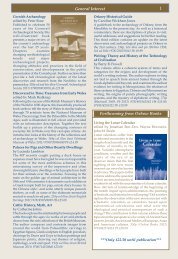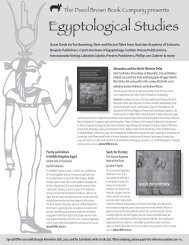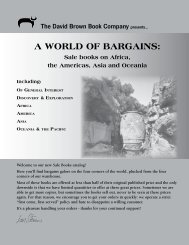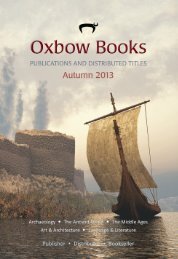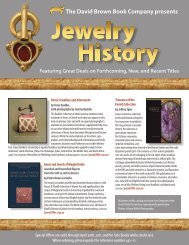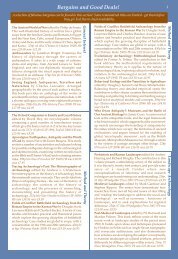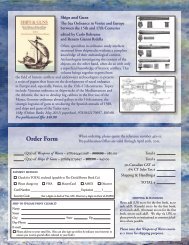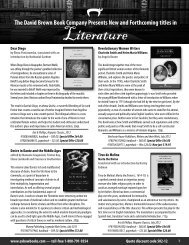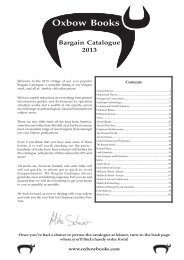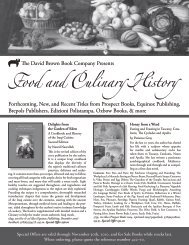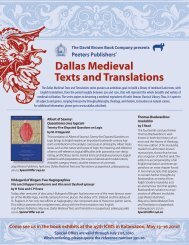Oxbow Spring 2013.pdf - Oxbow Books
Oxbow Spring 2013.pdf - Oxbow Books
Oxbow Spring 2013.pdf - Oxbow Books
You also want an ePaper? Increase the reach of your titles
YUMPU automatically turns print PDFs into web optimized ePapers that Google loves.
Hedingham Ware<br />
A Medieval Pottery Industry in North Essex; its Production and Distribution<br />
Helen Walker (Author)<br />
Between the 12th and 14th centuries, the Hedingham pottery industry produced<br />
decorated and glazed finewares, mainly jugs, and grey-firing coarsewares. This<br />
study provides a synthesis of Hedingham Ware production and explores its<br />
distribution within East Anglia. A gazetteer of the fourteen known production sites<br />
is provided, and the pottery is used to create a typology of fabric types, vessel<br />
forms and decoration for both fine and coarse wares. The industry appears to have<br />
evolved from the early medieval tradition, although it has similarities with Late<br />
Saxon Thetford-type ware. The coarsewares are most similar to those produced<br />
near Colchester and show some similarities to coarsewares produced in Suffolk.<br />
The Hedingham industry did not die out in the 14th century but became subsumed<br />
into the sandy orange ware tradition and lost its identity as Hedingham Ware.<br />
9781841940977, £20.00, Available Now<br />
PB, 200p, 96 illus, East Anglian Archaeology 148, East Anglian Archaeology<br />
The Coronation Chair and the Stone of Scone<br />
Warwick Rodwell (Author)<br />
Constructed in 1297−1300 for King Edward I, the Coronation Chair ranks amongst<br />
the most remarkable and precious treasures to have survived from the Middle<br />
Ages. It incorporated in its seat a block of sandstone, which the king seized at<br />
Scone, following his victory over the Scots in 1296. For centuries, Scottish kings<br />
had been inaugurated on this symbolic ‘Stone of Scone’, to which a copious<br />
mythology had also become attached. Edward I presented the Chair, as a holy<br />
relic, to the Shrine of St Edward the Confessor in Westminster Abbey, and most<br />
English monarchs since the fourteenth century have been crowned in it, the last<br />
being HM Queen Elizabeth II, in 1953.<br />
Medieval / Post Medieval<br />
The Chair and the Stone have had eventful histories: in addition to physical<br />
alterations, they suffered abuse in the eighteenth century, suffragettes attached<br />
a bomb to them in 1914, they were hidden underground during the Second<br />
World War, and both were damaged by the gang that sacrilegiously broke into<br />
Westminster Abbey and stole the Stone in 1950. It was recovered and restored<br />
to the Chair, but since 1996 the Stone has been exhibited on loan in Edinburgh<br />
Castle.<br />
Now somewhat battered through age, the Chair was once highly ornate, being<br />
embellished with gilding, painting and coloured glass. Yet, despite its profound<br />
historical significance, until now it has never been the subject of detailed<br />
archaeological recording. Moreover, the remaining fragile decoration was in need<br />
of urgent conservation, which was carried out in 2010−12, accompanied by the<br />
first holistic study of the Chair and Stone. In 2013 the Chair was redisplayed to<br />
celebrate the Diamond Jubilee of the Coronation of HM The Queen.<br />
The latest investigations have revealed and documented the complex history of<br />
the Chair: it has been modified on several occasions, and the Stone has been<br />
reshaped and much altered since it left Scone. This volume assembles, for the<br />
first time, the complementary evidence derived from history, archaeology and<br />
conservation, and presents a factual account of the Coronation Chair and the<br />
Stone of Scone, not as separate artefacts, but as the entity that they have been<br />
for seven centuries. Their combined significance to the British Monarchy and<br />
State – and to the history and archaeology of the English and Scottish nations – is<br />
greater than the sum of their parts.<br />
9781782971528, £28.00, June 2013<br />
HB, 320p, <strong>Oxbow</strong> <strong>Books</strong><br />
33




